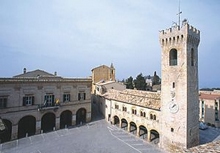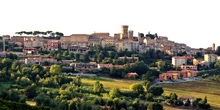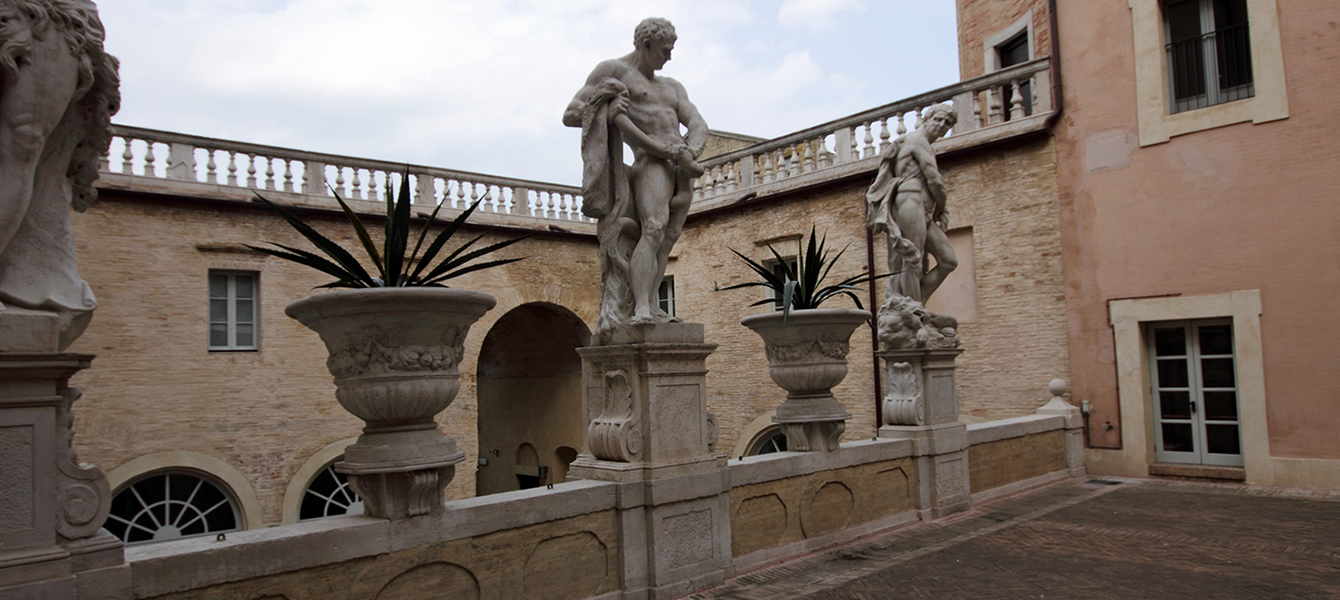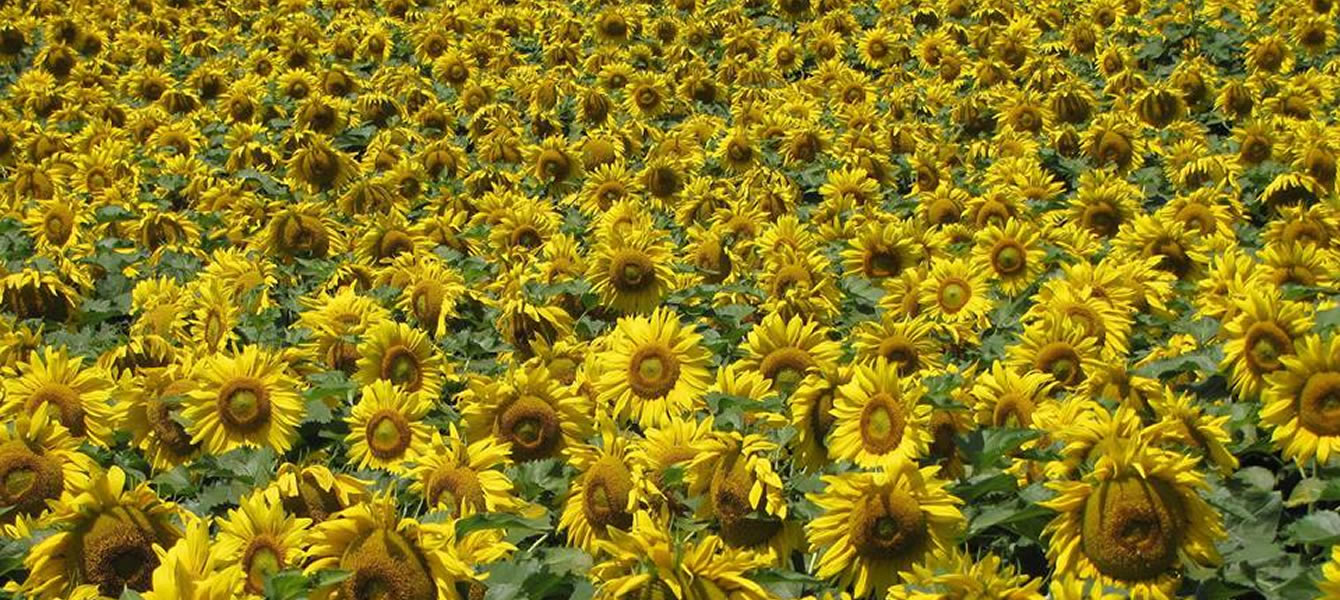Welcome to Macerata by Marche website
Tourist Guides in the Marche!
THE MOST BEAUTIFUL VILLAGES OF ITALY is a club, which collects little Italian centres with a marked historic and artistic interest.
The most beautiful Villages of the Marche region are:
- Cingoli
- Corinaldo
- Frontino
- Gradara
- Grottammare
- Macerata Feltria
- Mondolfo
- Matelica
- Mondavio
- Montecassiano
- Montecosaro
- Montefabbri
- Montefiore dell’Aso
- Monte Grimano Terme
- Montelupone
- Moresco
- Offagna
- Offida
- San Ginesio
- Sarnano
- Treia
- Visso
Guided tours to discover fascinating villages of art and architecture surrounded by nature.
-
<THE CHARMING VILLAGES OF THE SIBILLINI MOUNTAINS>San Ginesio and SarnanoThe province of Macerata
 SAN GINESIO, gem of the Sibillini Mountains, is an ancient typical medieval village (690 m. above sea level) known as the “Sibillini balcony” and has the name of his venerate patron saint. To visit with the guide: the Porta Picena, the Collegiate Church of 1080, in Romanesque-Gothic style, dedicated to our Mary of Annunciation; the Art Gallery rich in paintings, among which we can find a refined work ofn Ghirlandaio and some works of Simone de Magistris, one of the most Mannerism painters of the Marche region as well as a follower of Lorenzo Lotto.
SAN GINESIO, gem of the Sibillini Mountains, is an ancient typical medieval village (690 m. above sea level) known as the “Sibillini balcony” and has the name of his venerate patron saint. To visit with the guide: the Porta Picena, the Collegiate Church of 1080, in Romanesque-Gothic style, dedicated to our Mary of Annunciation; the Art Gallery rich in paintings, among which we can find a refined work ofn Ghirlandaio and some works of Simone de Magistris, one of the most Mannerism painters of the Marche region as well as a follower of Lorenzo Lotto. SARNANO is a charming medieval village (539 m. above sea level), his old town centre is characterized by the “red terracotta tile” of the roofs and by narrow and steep streets. To visit with the guide: the Piazza Alta with the Santa Maria Assunta Church of the XIII century; the Vittoria Theatre; the Palazzo Podestà and the Palazzo Priori; You can visit also the San Francesco Church of the XIV century, repeatedly reworked, and the Art Gallery, which preserves works of an extraordinary interest, in particular the Virgin with Child and the Angels of Vittore Crivelli.Visso and AmandolaThe province of Macerata
SARNANO is a charming medieval village (539 m. above sea level), his old town centre is characterized by the “red terracotta tile” of the roofs and by narrow and steep streets. To visit with the guide: the Piazza Alta with the Santa Maria Assunta Church of the XIII century; the Vittoria Theatre; the Palazzo Podestà and the Palazzo Priori; You can visit also the San Francesco Church of the XIV century, repeatedly reworked, and the Art Gallery, which preserves works of an extraordinary interest, in particular the Virgin with Child and the Angels of Vittore Crivelli.Visso and AmandolaThe province of Macerata VISSO, is a fascinating mountain centre considered as the “pearl” of the Sibillini Mountains and is the location of the Natural Park too. It is proud of a past rich in history and architectural features such as the majestic walls, the medieval balconies, the houses, the towers, the refined palaces of the Renaissance, the stone gates full of Latin mottoes and family emblems that form a harmonic combination. To visit with the guide: the piazza dei Martiri Vissani with the St. Maria Collegiate Church, in a Romanic-gothic style and the ex-Church of Sant’Agostino of the XIV century which hosts the Civic and Diocesan Museum-Art Gallery and the Leopardi’s manuscripts Museum; the Palazzo dei Priori and the palazzo del Divino Amore.
VISSO, is a fascinating mountain centre considered as the “pearl” of the Sibillini Mountains and is the location of the Natural Park too. It is proud of a past rich in history and architectural features such as the majestic walls, the medieval balconies, the houses, the towers, the refined palaces of the Renaissance, the stone gates full of Latin mottoes and family emblems that form a harmonic combination. To visit with the guide: the piazza dei Martiri Vissani with the St. Maria Collegiate Church, in a Romanic-gothic style and the ex-Church of Sant’Agostino of the XIV century which hosts the Civic and Diocesan Museum-Art Gallery and the Leopardi’s manuscripts Museum; the Palazzo dei Priori and the palazzo del Divino Amore. AMANDOLA, is a small mountain village at the foot of the Sibillini mountains which presents an old town centre clinging to the summit of the hill. To visit with the guide: the piazza Alta, the Chiesa di S. Antonio and the historic theatre “La Fenice”.
AMANDOLA, is a small mountain village at the foot of the Sibillini mountains which presents an old town centre clinging to the summit of the hill. To visit with the guide: the piazza Alta, the Chiesa di S. Antonio and the historic theatre “La Fenice”. -
<THE CHARMING VILLAGES ON THE HILLSIDE>Montelupone and MontecassianoThe province of Macerata
 MONTELUPONE is a little centre characterized by the historical walls and by the four gateways, which during the centuries were closed at the sunset and opened at the sunrise and preserves even now the original pavement in stone. To visit with the guide: the Palazzetto del Podestà (or dei Priori) with the Civic Tower; the Town Hall with the historic Nicola Degli Angeli Theatre; the St. Francesco Church (the second half of the XIII century) reworked in a late Baroque style.
MONTELUPONE is a little centre characterized by the historical walls and by the four gateways, which during the centuries were closed at the sunset and opened at the sunrise and preserves even now the original pavement in stone. To visit with the guide: the Palazzetto del Podestà (or dei Priori) with the Civic Tower; the Town Hall with the historic Nicola Degli Angeli Theatre; the St. Francesco Church (the second half of the XIII century) reworked in a late Baroque style. MONTECASSIANO is a medieval village characterized by a spiral structure, which arrives to the summit of the little square on the hill. To visit with the guide: the Town Hall; the Santa Maria Assunta Collegiate Church, founded by the monks of the Fiastra Abbey; the Santa Maria Della Misericordia Collegiate Church;; the Palazzo dei Priori and the Porta Cesare Battisti. We can also visit the Confraternity Museum in the St. Giacomo Church, the Archaeological Museum; the ancient St. Marco Church and the small St. Nicolò Church.Cingoli and TreiaThe province of Macerata
MONTECASSIANO is a medieval village characterized by a spiral structure, which arrives to the summit of the little square on the hill. To visit with the guide: the Town Hall; the Santa Maria Assunta Collegiate Church, founded by the monks of the Fiastra Abbey; the Santa Maria Della Misericordia Collegiate Church;; the Palazzo dei Priori and the Porta Cesare Battisti. We can also visit the Confraternity Museum in the St. Giacomo Church, the Archaeological Museum; the ancient St. Marco Church and the small St. Nicolò Church.Cingoli and TreiaThe province of Macerata CINGOLI, also known as the “Balcony of the Marche” for his position, offers a breath-taking view as far as the eye can see.
CINGOLI, also known as the “Balcony of the Marche” for his position, offers a breath-taking view as far as the eye can see.
To visit with the guide: the beautiful Piazza Vittorio Emanuele II, with the medieval Town Hall, which presents a façade of the 1530 and a tower with a clock of the XV century; the Civic Archaeological Museum which preserves precious prehistoric and Hellenic-Romanic finds; the Cathedral; the St. Filippo Neri Church; the St. Domenico Church; the St. Esuperanzio Church in a Romanic-gothic style and the Palazzo Castiglioni Museum which preserves important relics of Pope Pius VIII. TREIA is a small town with an antique flavour and the lively spirit, embraced by picturesque natural scenery and a majestic surrounding towered walls. A distinctive trait is the picturesque collocation of little houses along a tight path looking to the valley of Potenza river. To visit with the guide: the Piazza della Repubblica with the Town Hall; the Civic Archaeological Museum; the Piazza della Repubblica; Il SS. Crocefisso Sanctuary, the Cathedral established in the XVIII century; the St. Michele Church; and the St. Chiara Church, reworked in a late Baroque style.
TREIA is a small town with an antique flavour and the lively spirit, embraced by picturesque natural scenery and a majestic surrounding towered walls. A distinctive trait is the picturesque collocation of little houses along a tight path looking to the valley of Potenza river. To visit with the guide: the Piazza della Repubblica with the Town Hall; the Civic Archaeological Museum; the Piazza della Repubblica; Il SS. Crocefisso Sanctuary, the Cathedral established in the XVIII century; the St. Michele Church; and the St. Chiara Church, reworked in a late Baroque style. -
<THE CHARMING VILLAGES ON THE HILLSIDE>Offagna and CorinaldoThe province of Ancona
 OFFAGNA is a beautiful medieval village (309 m. above sea level) rising on the soft and fertile hills of the Marche region’s hinterland. It has a panoramic position and is dominated by the great medieval Rocca (Fortress). To visit with the guide: the Town Hall; the SS. Sacramento Church projected by the architect Vici (1780); the Paolucci Museum, created to save the find collection of flora and fauna completed in the first XX century by the scientist and naturalist Luigi Paolucci in the Conero area.
OFFAGNA is a beautiful medieval village (309 m. above sea level) rising on the soft and fertile hills of the Marche region’s hinterland. It has a panoramic position and is dominated by the great medieval Rocca (Fortress). To visit with the guide: the Town Hall; the SS. Sacramento Church projected by the architect Vici (1780); the Paolucci Museum, created to save the find collection of flora and fauna completed in the first XX century by the scientist and naturalist Luigi Paolucci in the Conero area.
CORINALDO is a village with a strategic position situated between the Marca di Ancona and the Stato di Urbino. Its symbol are the majestic walls of the XV century practically remained intact. To visit with the guide: the imposing St. Francesco Church; the Addolorata Church, which is the aim of pilgrimages due to the crypt dedicated to St. Maria Goretti; the Municipal Theatre and the Casa del Trecento; the St. Maria del Piano Early Cristian Church..Offida and RipatransoneThe province of Ascoli Piceno OFFIDA is a splendid medieval village renowned for the manufacturing of bobbin lace. The village has kept intact its urban structure and the old town centre enclosed by crenellated walls.
OFFIDA is a splendid medieval village renowned for the manufacturing of bobbin lace. The village has kept intact its urban structure and the old town centre enclosed by crenellated walls.
To visit with the guide: the triangular Piazza del Popolo; the Town Hall with the characteristic crenellated façade; the eighteenth-century Serpente Aureo Theatre; the Collegiate Church; the Palazzo De Castellotti which hosts a Group of Museums: the Archaeological Museum, the Popular Traditions Museum and the Lace Museum; the suggestive medieval St. Maria della Rocca Church, rich in extraordinary fourteenth-century paintings. RIPATRANSONE is one of the oldest town centre in the province of Ascoli Piceno, situated on a hill (500 m. above sea level) and near the seaside. To visit with the guide: the St. Gregory Magno and St. Margherita Cathedral (XVI-XVII centuries); the Immaculate Church (or di St. Filippo) of the late XVII century; the St. Michele Arcangelo Church, in a Romanesque style with Renaissance paintings of the XV-
RIPATRANSONE is one of the oldest town centre in the province of Ascoli Piceno, situated on a hill (500 m. above sea level) and near the seaside. To visit with the guide: the St. Gregory Magno and St. Margherita Cathedral (XVI-XVII centuries); the Immaculate Church (or di St. Filippo) of the late XVII century; the St. Michele Arcangelo Church, in a Romanesque style with Renaissance paintings of the XV-
XVI centuries and with the oldest baptismal font of the town. You can also, discover the Narrowest Alley of Italy (43 cm. wide), the palazzo del Podestà of 1307 with Luigi Mercatini Theatre. -
<THE CHARMING ANCIENT VILLAGES OVERLOOKING THE SEA>Grottammare Alta and Torre di PalmeThe province of Ascoli Piceno
 GROTTAMMARE ALTA, called the “pearl” of the Adriatic Sea, is a characteristic medieval village overlooking the sea. To visit with the guide: the St. Agostino Church of the XVI century; the Piazzetta Peretti and the Clock Tower; the historic Theatre dell’Arancio;; the St. Lucia Church (1597) and the St. Giovanni Battista (St. John the Baptist) Church with the Sistino Museum.
GROTTAMMARE ALTA, called the “pearl” of the Adriatic Sea, is a characteristic medieval village overlooking the sea. To visit with the guide: the St. Agostino Church of the XVI century; the Piazzetta Peretti and the Clock Tower; the historic Theatre dell’Arancio;; the St. Lucia Church (1597) and the St. Giovanni Battista (St. John the Baptist) Church with the Sistino Museum. TORRE DI PALME is an ancient medieval village rising on the top of a hill near the Adriatic coast. To vist with the guide: St. Agostino Church dating from the XII century in a Romanesque style, whose inside preserves a polyptych of Vittorio Crivelli and a painting of Vincenzo Pagani. You can also visit the St. Giovanni Church (St. John Church)of the X century, one of the first buildings of village; the Palazzetto dei Priori of the XII century; admire various panoramic points with breath-taking sea views and the bosco del Cugnòlo which represents a path of environmental interest and guides to the legendary “Grotta degli Amanti (“Lovers Cave”)”, among the Mediterranean flora at the foot of a ravine.Moresco and MondolfoThe province of Fermo
TORRE DI PALME is an ancient medieval village rising on the top of a hill near the Adriatic coast. To vist with the guide: St. Agostino Church dating from the XII century in a Romanesque style, whose inside preserves a polyptych of Vittorio Crivelli and a painting of Vincenzo Pagani. You can also visit the St. Giovanni Church (St. John Church)of the X century, one of the first buildings of village; the Palazzetto dei Priori of the XII century; admire various panoramic points with breath-taking sea views and the bosco del Cugnòlo which represents a path of environmental interest and guides to the legendary “Grotta degli Amanti (“Lovers Cave”)”, among the Mediterranean flora at the foot of a ravine.Moresco and MondolfoThe province of FermoThe medieval village of
 MORESCO takes its form from the old elliptic castle and from its position over the green Aso valley. To visit with the guide: the Tower, with a spectacular panoramic view over hills, valleys and seaside; the Castello (Castle) with narrow streets, old houses in terracotta tile and great portals and the triangular square with the colonnade and paintings. You can also visit the Madonna della salute Sanctuary the Town Hall which preserves various works coming from churches and privates collections among which a big altarpiece of Vincenzo Pagani. There is also the Madonna dell’Olmo Church which preserves right inside a religious aedicule painted by Pagani.
MORESCO takes its form from the old elliptic castle and from its position over the green Aso valley. To visit with the guide: the Tower, with a spectacular panoramic view over hills, valleys and seaside; the Castello (Castle) with narrow streets, old houses in terracotta tile and great portals and the triangular square with the colonnade and paintings. You can also visit the Madonna della salute Sanctuary the Town Hall which preserves various works coming from churches and privates collections among which a big altarpiece of Vincenzo Pagani. There is also the Madonna dell’Olmo Church which preserves right inside a religious aedicule painted by Pagani. MONDOLFO rises on a hill just in front of the Adriatic Sea in an enchanting position. To visit with the guide: the St. Anna Bastion and the Martiniano Garden (XVI century), the Giraldi Della Rovere Palace and the Peruzzi Palace (XVI century), the St. Maria Del Soccorso Church (XVI century) and the St. Agostino Monastery (XVII century), the St. Giustina Collegiate Church (XVIII century) and the Madonna Delle Grotte Sanctuary (XVII century).
MONDOLFO rises on a hill just in front of the Adriatic Sea in an enchanting position. To visit with the guide: the St. Anna Bastion and the Martiniano Garden (XVI century), the Giraldi Della Rovere Palace and the Peruzzi Palace (XVI century), the St. Maria Del Soccorso Church (XVI century) and the St. Agostino Monastery (XVII century), the St. Giustina Collegiate Church (XVIII century) and the Madonna Delle Grotte Sanctuary (XVII century).

















